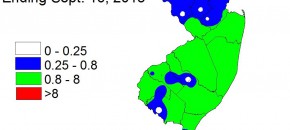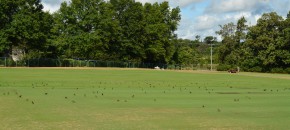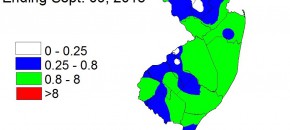Extended periods of long, hot dry weather can cause pumpkin fruit to seemingly mature quicker (i.e., turn orange). Sunscald injury occurs when cucurbit fruit are suddenly exposed to direct sunlight during the latter stages of fruit ripening during the fall. Sunscald injury often occurs after plants prematurely defoliate due to powdery mildew or downy mildew infection or when vines collapse […]
Continue reading...Vegetable Disease Briefs – 9/21/15
Downy mildew remains active on all cucurbit crops. All cucurbit growers should include downy as well as powdery mildew specific fungicides in their weekly maintenance sprays. Please remember different modes-of-Action (i.e., FRAC groups) to help manage fungicide resistance develop in both pathogens. To track the progress of CDM in the US please visit http://cdm.ipmpipe.org/ There […]
Continue reading...Veg IPM Update: Week Ending 9/16/15

Sweet Corn Only a scattering of European corn borer (ECB) moths are being captured now, with somewhat more consistent catches in Mercer County (see ECB map). Damage from this pest is largely being overshadowed by that of the fall armyworm. As always, consider treating when the number of infested plants in a 50 plant sample […]
Continue reading...RAREC Variety Trials:
Disease-Resistant Hybrid Bell Pepper ‘Turnpike’

Phytophthora blight (P. capsici) and bacterial leaf spot (BLS) are the two greatest pathogen threats to pepper production in New Jersey. Articles in the Plant & Pest Advisory, such as Phytophthora Control During Wet Weather, Controlling Phytophthora Blight in Pepper, and Bacterial Leaf Spot Update, have talked about why growers are experiencing increasing crop losses […]
Continue reading...Better Late Than Never

Today’s rain got me thinking about insect damage in turfgrass. Actually I’ve been thinking about insect damage in turf for a week or so, ever since I saw a flock of birds pecking sod webworms out of the bentgrass plots behind the Plant Diagnostic Laboratory.
Continue reading...Veg IPM Update: Week Ending 9/9/15

Sweet Corn The second European corn borer (ECB) generation is lingering at low levels, primarily in central counties (see ECB map). As always, consider treating when the number of infested plants in a 50 plant sample exceeds 12%. Any planting remaining at or above threshold as it proceeds to full tassel should be treated, as […]
Continue reading...